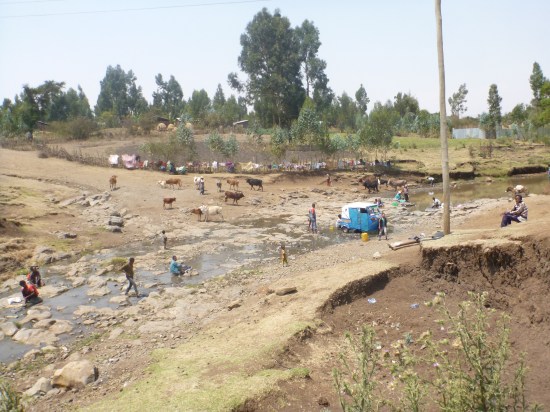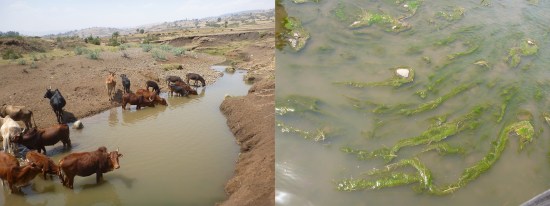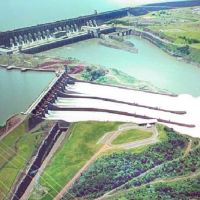Assessing Ethiopian river water quality: indicator choice matters

A guest blog by Daniel Hayes from the Institute of Hydrobiology and Aquatic Ecosystem Management (IHG), BOKU, Vienna.
+++
Imagine you are a river basin manager and have to decide on the best methods to assess the water quality of the streams and rivers in your catchment. What would you choose? Considering that in the European Union alone, there are over 300 different biological assessment methods, this is surely not an easy task!
In numerous countries across the world – especially developing countries – many people depend directly on river water for drinking, domestic purposes, crop irrigation and providing water to animals (see picture above). Even though these activities require appropriate water quality to be used safely, many river systems are under severe pressure due to human activities. Microbial fecal pollution of river water from sewage waste, for example, can often have wide-ranging negative implications for public health.
Fecal and biotic indicators of water quality
Fecal ‘indicator bacteria’, such as Escherichia coli and enterococci are commonly used to assess pollution levels in aquatic environments. Measuring the abundance of these indicator bacteria allows conclusions to be drawn regarding the public health risks associated with river water use. These assessments, however, require extensive laboratory equipment and finances, which might not be available in all situations.
One alternative to fecal indicator bacteria are biotic indicators such as benthic macroinvertebrates (aquatic insects). Biotic indicators can provide an integrative and cumulative measure of ecosystem health based on the combined responses of communities to stressors in the aquatic ecosystem. Such benthic macroinvertebrate assessment systems have been recently developed and tested in Ethiopia.
Assessing water quality indicators in Ethiopian rivers
In light of the need to compare the performance of different approaches for assessing water quality status, a team of Austrian, Ethiopian and Tanzanian researchers have recently published a new study.
They evaluated the consistency of fecal indicator bacteria for environmental health assessments of rivers by comparing them to assessments of physicochemical tests, as well as to macroinvertebrate indices. The scientists sampled five sites along a land-use pressure gradient on the Upper Awash River, the headwater section of one of the most important river basins in Ethiopia.
The results were shocking: the concentrations of two tested fecal indicator bacteria (E. coli and enterococci) exceeded the standards set by the European Union and the World Health Organization for safe recreational water. Hence, all sites were categorised as ‘poor’ for swimming and recreation.
According to the World Health Organization, this classification is associated with a >10% chance of gastroenteritis per single exposure. Hence, even though these guidelines pertain primarily to recreational activities such as swimming, it can be assumed that the low bacteriological water quality may also have adverse impacts on human health if water is used for the irrigation of fresh produce, drinking or domestic purposes.

Fecal and biotic indicators produce contrasting water quality assessments
Surprisingly, in contrast, the three tested African benthic macroinvertebrate indices (from South Africa, Tanzania, and Ethiopia) indicated a natural or good ecological status with slight ecological degradation at the upstream sites, and a moderate to poor status at the downstream sites. Hence, the macroinvertebrate indices reflected changes in land-use from natural forests in the headwaters to highly modified agricultural landscapes in the lower reaches.
“Considering the high values of fecal indicator bacteria, the use of river water may cause significant public health hazards, particularly to young, elderly or immunocompromised people,” says lead author Geda Kebede. “In light of this risk, it is important to establish appropriate management measures,” Kebede recommends.

Such measures could include immediate actions such as informing the public about the risks associated with water uses, or more long-term actions such as reducing fecal pollution sources. Livestock grazing in the Upper Awash River basin is a key driver of fecal indicator bacteria contamination in the river ecosystem. Therefore, solutions could include preventing cattle from entering the river zone, providing off-stream watering, and restoring riparian vegetation as buffer zones.
Summarising, this is the first study of its kind reporting the different results of water quality status assessments using fecal bacteria and macroinvertebrate indicators. Consequently, from the viewpoint of river basin management, it seems necessary to combine different indicator systems to analyse human pressures from a more holistic perspective.
+++















Comments are closed.